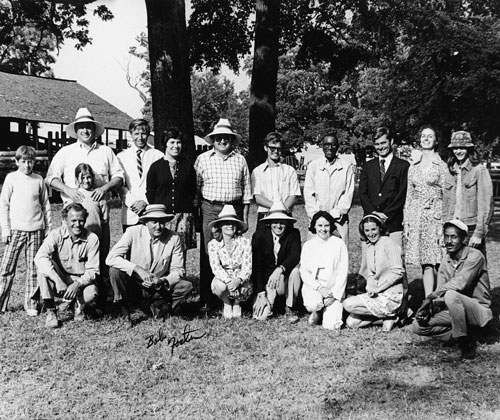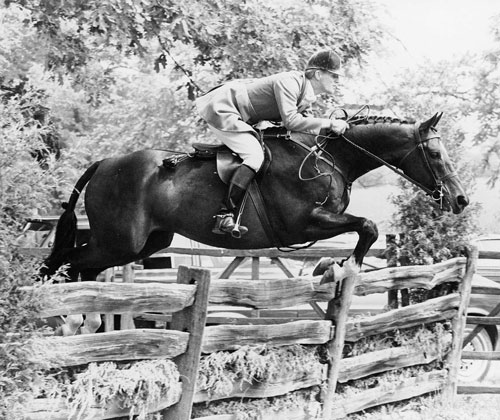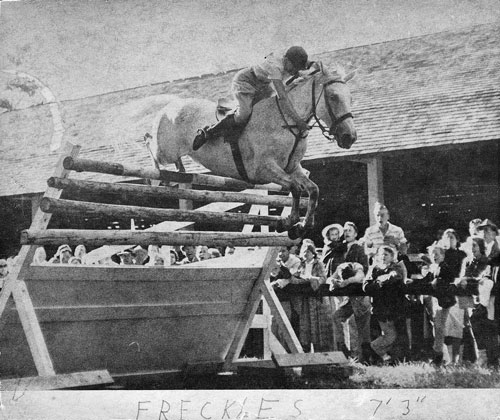Stories from Upperville
Top riders share their memories from the oldest horse show in the nation
One cold day in the winter of 1853, Colonel Richard Henry Dulany, gentleman planter and sportsman, was riding through his fields when he found a colt cast in a low fence. Upon freeing the young horse, he discovered the colt’s feet had frozen, which added to the dismay he already felt about the living conditions of horses who were typically regarded by his fellow planters solely as sources of labor. To encourage better treatment of horses and improve the local breeding, he resolved to establish America’s first horse show. He chose as a site a beautiful section of his property two miles east of the village of Upperville, a farm characterized by a breathtaking setting with stately oak trees, a panoramic view of the Blue Ridge Mountains, and soft grassy areas that would be kind to the horses’ feet. The Upperville Union Club, as it was originally called, continued until the start of the Civil War, and resumed in 1869, again under Colonel Dulany’s leadership, who continued in this role until 1906. By that time he had rebranded the show as The Upperville Colt and Horse Club, and classes had been expanded to include ponies, coaching, and saddle horses. Over the next hundred years, the Upperville Horse Show became established as arguably the most prestigious horse show in America.
During this time, traditions were established by families who have now supported the event for generations. Mrs. A.C. Randolph, President for more than 15 years, was the primary supporter whose generosity provided the foundation for the show’s success. Nick and Mildred “Bucky” Slater of Upperville have both been involved in the show throughout their lives, and when Nick became President he followed his father and grandfather in a family tradition of leadership. Bucky has worked on the show as a lawyer, but her first experience was as a child, and her daughter competed in a lead line class, as Nick had as a child. Elizabeth Busch Burke was an important supporter, along with other community leaders. Upperville added jumping classes, and patrons could watch a range of riders, including small children riding lead line ponies, ladies riding sidesaddle (being inspected for everything from pristine turnout to proper luncheon packing), and jumpers scaling huge walls. Nancy Lee, Secretary of the show throughout the 1960’s, was succeeded by her daughter Punkin in the 1970’s, and Punkin recalls how it became a tradition for many of the local families to do their best to make Upperville a special and fun experience for both competitors and spectators.
Many of the world’s best riders have vivid memories of competing at Upperville. Joe Fargis, 1984 Olympic Gold Medal winner, has ridden in Upperville since 1960, and he remembers that the Upperville show was “…always a centerpiece. Everyone would come to see all the best horses.” Joe began riding while still in school, and he has now ridden hunters and jumpers in every corner of the showgrounds; in fact, he has ridden in every hunter and jumper division and judged every jumping class. Katie Monahan-Prudent has also ridden hunters, jumpers, and Grand Prix horses at Upperville since the mid 1970’s, and she remembers the “…unmatchable setting…” and variety of classes that has always set Upperville apart from other shows on the circuit. Similarly, Grand Prix champion Aaron Vale has long competed at Upperville, which he sees as a “…classic traditional horse show … one of my favorite shows on the calendar.”
Upperville has many attractions for riders, and none is more powerful than its magnificent location. With soft rings overshadowed by ancient oaks and the mountain backdrop, Upperville has always been a stunningly beautiful show. In addition, Upperville has long been an inclusive family horse show that attracts a wide variety of riders and spectators. In the early days, the trees were associated with families who would gather under specific oaks to share meals, today that tradition has been transformed to a system of tables and tents where participants and spectators still gather to eat, drink, and socialize. Katie Prudent loves that she can coach and ride jumpers but walk across the street to see breeding, lead line, and hunter classes. “It is not as formal as most shows…” she says. “People come out of the woodwork to go to Upperville…” and she remembers running into dear friends such as Tab Hunter. For more than a hundred and sixty years, equine enthusiasts have been telling each other, “I’ll see you in June at Upperville!”
Joe Fargis and Katie Prudent agree that as many horse shows have become more regimented, orchestrated, and generic, Upperville’s uniqueness has become even more appealing. Katie remembers one special event the day before she and her husband Henri competed in the Upperville Grand Prix. “We were showing two grey mares owned by the Firestones, Silver Skates and Partly Cloudy, and the day before the Grand Prix we decided to take them on a trail ride. We went out for three hours and jumped every board fence and every stream we encountered. The next day at Upperville we came in first and second place. I don’t know any other horse show where that could happen.” Most modern horse shows are not set in an expansive, rural landscape where virtually everyone expects and welcomes riders. Joe agrees: “There are not many venues like this now.”
Upperville’s outdoor setting also presented the show’s greatest challenge: the event is always subject to the whims of the weather, and rain always had the potential to temporarily ruin the outdoor grass ring. Tommy Lee Jones, who started riding at Upperville in 1955 and who has been managing the show since 1982, remembers years when the show was all but washed away. Rain could be particularly devastating in the early 80’s, before the show had the present infrastructure for electricity and water. He remembers one year when water was in such short supply that riders were forbidden to clean their horses’ legs, and anyone who responded to a callback on a horse with clean legs was summarily disqualified. Even when the infrastructure for water and electricity was installed, rain could still devastate the natural grass rings. Tommy Lee remembers horse trailers getting stuck in the muck beside and sometimes in the grass ring. The situation reached a crisis in 2003, when Tommy Lee recalls, “It started raining Sunday night, and it rained all week.” Nick Slater arranged for a helicopter to hover over the Grand Prix jumper field, which dried the ring and changed the minds of participants who were about to pull out. Aaron Vale remembers being stranded in the drenching rain at Upperville because the new rig he had ordered had not arrived, so he had little choice but to ride in the Grand Prix. He won the lion’s share of the $150,000 purse.
Something had to change. The show had reached a crossroads: was Upperville going to remain a local country show, or was it going to make the changes necessary to continue to attract the world’s best riders? By all accounts, a new generation of local leaders stepped up to make the needed changes, including current Board President Barbara Roux, Vice Presidents Shelby Bonnie, Dr. Betsee Parker (who began a tradition of providing food and refreshments to grateful riders and trainers on set-up day), Manual Johnson, Punkin Lee, Mike Smith, and Colonel John Zugschwert. Other key community leaders were Mr. and Mrs. Robert Smith, whom Tommy Lee Jones identifies as “…the best thing that ever happened to the Upperville Show.” While they couldn’t control the weather, they could dramatically improve the footing by renovating the rings. Joe Fargis remembers that in 1960, “…riders would have been content with a rock pile, but modern riders are much more concerned about the health of their horses.” The rings at Upperville were renovated to the state-of-the art standard, with the ability to control moisture content. Now, Joe Fargis claims, “Upperville has the best footing in the country…” and Tommy Lee Jones has been told by international competitors that it is “…the best in the world.”
Today, Upperville retains the charm of a traditional country show, with limited commercialism, a wide variety of classes, a traditional outdoor grandstand for spectators, and stunning vistas. It is a place where show manager Tommy Lee Jones remembers being unable to ride in 1958 because of a broken collarbone, so Kathy Kusner rode his mare Freckles and set a record jump of 7’3” — where Joe Fargis recalls getting out of school so he could compete — where adults help groom their children’s ponies while they remember competing in the lead line as children themselves. Upperville has charm, beauty, and deep traditions. At the same time, the show now attracts the top horses and riders in the world, as well as more than 20,000 spectators each year. Tommy Lee Jones knows that Upperville has been changing for 166 years, and he is sure the show will keep evolving. “Upperville is an old horse show that is looking to the future,” he says, “…but we remember the past.” Katie Prudent agrees: “Upperville draws big names, but it still maintains its community feel. It is a very special old-style horse show. I love it.” Punkin Lee has perhaps the best advice for participants and spectators: “Go to Upperville and enjoy the ride!”
Dr. Huntington Lyman is the Academic Dean of The Hill School in Middleburg, where he has taught since 1984.




